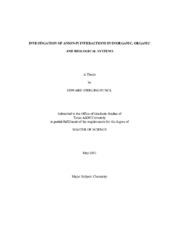| dc.description.abstract | Despite an ever growing number of reports concerning the anion-π interaction, controversy surrounding the nature of these weak supramolecular interactions continues. In an effort to further explore the nature and properties of anion-π interactions, experimental and computational methods were employed to study their occurrence in inorganic, organic and biological systems.
As part of ongoing research in the Dunbar group on the topic of anion-π based supramolecular interactions, the ligand 3,6-bis(2′-pyrimidyl)-1,2,4,5-tetrazine (bmtz) was synthesized and reacted with [Cu(NCMe)4][BF4] to form the octanuclear complex [Cu8(bmtz)6][BF6]6·6MeCN. Crystallographic evidence indicates an in situ reduction of two of the complexed bmtz ligands to radical anions. A second blue compound has also been observed in this reaction, and recent work has resulted in a direct synthesis of this compound. Preliminary results indicate that this second compound contains Cu(II) centers, as expected. Further work is necessary to identify the second blue compound.
In an effort to explore the fundamental question of whether or not anion-π interactions can occur between complex anions and olefins a series of Density Functional Theory and ab initio computations have been preformed for the tetracyanoethylene, 7,7,8,8-tetracyanoquinodimethane, 7,7,8,8-tetracyano-1,2,4,5-tetrafluoroquinodimethane and octacyanoquinodimethane molecules with the anions tetrafluoroborate and hexaflurophosphate. These optimizations indicate favorable interactions for all cases and are further supported by critical point analysis, performed using the Atoms in Molecules theory, and Natural Bond Orbitals analysis.
DFT and NBO computations were also employed to explore the simultaneous anion-π and π-type charge transfer interactions observed between 1,4,5,8,9,12-hexaazatriphenylene-hexacarbonitrile and the chloride, bromide and iodide anions, as observed previously by the Dunbar group. Computations involving chloride and bromide anions are in full agreement with the previously reported spectroscopic and crystallographic evidence.
Finally, the question of whether or not anion-π interactions occur in proteins was investigated by searching the Protein Data Bank for interactions between chloride or iodide anion and the aromatic moieties of the phenylalanine, tyrosine and tryptophan residues. Computer scripts were specifically written for this search and revealed promising interactions between chloride anions and all three amino acids. Procedural and statistical considerations preclude these examples from being definitive. | en |


